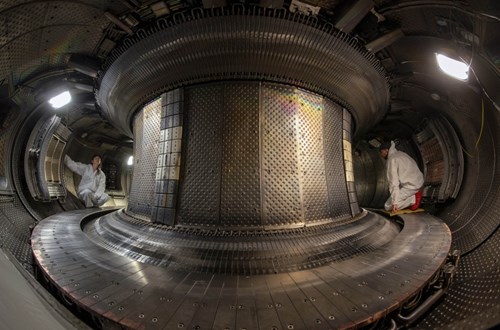 Someone waking up inside of WEST, the French tokamak located barely one kilometer away from ITER, would think they had been transported into an alien spaceship—and more specifically, into the stranded star-faring vessel in the movie Alien (1979), with its strange ribcage-like walls and dull metal vertebrae. Last week, a (perfectly awake) Newsline reporter was privileged to spend a few hours inside the machine's plasma chamber, where some of the longest plasma shots in fusion history were produced.
Someone waking up inside of WEST, the French tokamak located barely one kilometer away from ITER, would think they had been transported into an alien spaceship—and more specifically, into the stranded star-faring vessel in the movie Alien (1979), with its strange ribcage-like walls and dull metal vertebrae. Last week, a (perfectly awake) Newsline reporter was privileged to spend a few hours inside the machine's plasma chamber, where some of the longest plasma shots in fusion history were produced.
WEST is more than an upgrade from the quarter-century-old Tore Supra tokamak: it is a reinvented machine that now serves as a test bench and risk-limiter for ITER. Having replaced its previous carbon/carbon fiber limiter with an ITER-grade full-tungsten divertor (hence the "W" in WEST, for the chemical symbol of tungsten), the tokamak launched its first experimental campaign in 2017 with only a few actively cooled plasma-facing units. Five years later WEST, housed at the French nuclear research center CEA Cadarache, had a fully operational ITER-grade divertor and had launched its "Phase II" campaign centered on a succession of high-fluence pulses reaching or exceeding 100 seconds.
With a new experimental campaign set to begin in November, WEST is presently being conditioned and equipped with new systems and components. A refurbished electron cyclotron resonance heating (ECRH) antenna has been installed, a small proportion of Chinese-procured divertor elements have been replaced with European equivalents, divertor elements are being equipped with ITER-like divertor thermocouples, and various cleaning and analysis operations are being performed.
It is into this veteran but completely rejuvenated machine that this reporter crawled last week at the CEA's invitation.
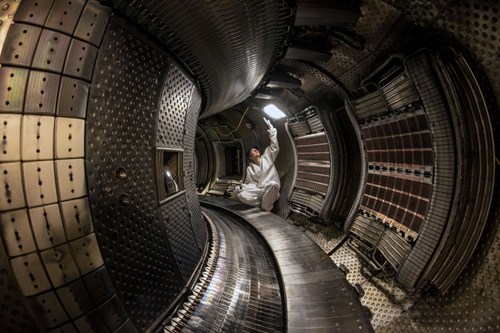 Running parallel at the bottom of this image, the ITER-grade divertor and its ''baffle,'' whose role is to increase particle pumping efficiency while protecting the divertor; to the right, two lower hybrid current drive (LHCD) antennas that deliver a maximum of 3 MW and 4 MW of heating power respectively. Further into the torus is one of the three ion cyclotron resonance heating (ICRH) antennas, each delivering 3 MW of heating power. The vertical element to the left, attached to the vacuum vessel's inner wall is one of the six ''bumpers'' designed to sustain plasma during start-up and ramp-down (or dedicated experiments) during a few seconds. The upper divertor is visible at the top left of the image. WEST is equipped with two divertors, upper and lower, that provide added flexibility for the experimental program.
Running parallel at the bottom of this image, the ITER-grade divertor and its ''baffle,'' whose role is to increase particle pumping efficiency while protecting the divertor; to the right, two lower hybrid current drive (LHCD) antennas that deliver a maximum of 3 MW and 4 MW of heating power respectively. Further into the torus is one of the three ion cyclotron resonance heating (ICRH) antennas, each delivering 3 MW of heating power. The vertical element to the left, attached to the vacuum vessel's inner wall is one of the six ''bumpers'' designed to sustain plasma during start-up and ramp-down (or dedicated experiments) during a few seconds. The upper divertor is visible at the top left of the image. WEST is equipped with two divertors, upper and lower, that provide added flexibility for the experimental program.
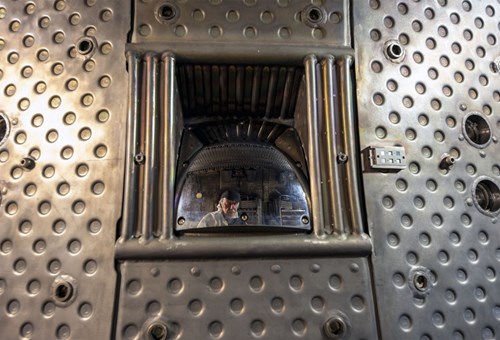 This convex mirror is designed to reflect the image of the antenna across the way acquired by the infrared thermography system. Monitoring the thermal parameters of the antennas is essential as overheating could severely damage them. Made in massive molybdenum, the mirrors are actively cooled, and polished to provide high optical quality.
This convex mirror is designed to reflect the image of the antenna across the way acquired by the infrared thermography system. Monitoring the thermal parameters of the antennas is essential as overheating could severely damage them. Made in massive molybdenum, the mirrors are actively cooled, and polished to provide high optical quality.
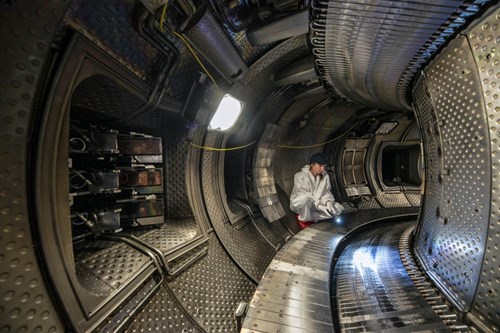 To the left, the recently installed electron cyclotron resonance heating (ECRH) antenna. It will be commissioned in the second semester of the coming year and will progressively deliver 3 MW of heating power.
To the left, the recently installed electron cyclotron resonance heating (ECRH) antenna. It will be commissioned in the second semester of the coming year and will progressively deliver 3 MW of heating power.
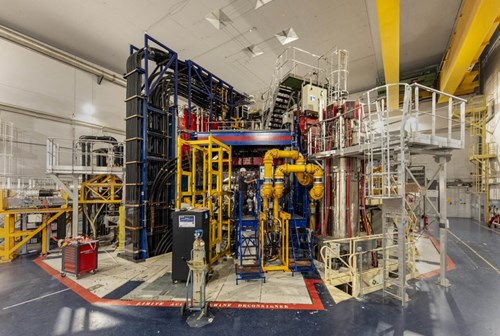 Construction of Tore Supra, then the second largest tokamak in the world, began at CEA-Cadarache in 1982. The first fusion machine to be equipped with superconducting coils, Tore Supra produced its first plasma in 1988. In 2003, the CEA tokamak established a record for plasma duration with a 6.30-minute-long shot (the record held for close to two decades until the Chinese tokamak EAST achieved a 17-minute shot in 2022). Beginning in 2013 Tore Supra was progressively revamped into WEST to serve as a test bench and risk limiter for ITER.
Construction of Tore Supra, then the second largest tokamak in the world, began at CEA-Cadarache in 1982. The first fusion machine to be equipped with superconducting coils, Tore Supra produced its first plasma in 1988. In 2003, the CEA tokamak established a record for plasma duration with a 6.30-minute-long shot (the record held for close to two decades until the Chinese tokamak EAST achieved a 17-minute shot in 2022). Beginning in 2013 Tore Supra was progressively revamped into WEST to serve as a test bench and risk limiter for ITER.
Top Image: With a plasma volume of 15 cubic meters, WEST is a medium-size tokamak comparable to Korea's KSTAR (~17 m³), Germany's Asdex Upgrade (~13 m³) or China's EAST (~17 m³). Only the European JET (80 m³) and the Europe-Japan JT60-SA (140 m³, in commissioning) offer more plasma volume.
All images courtesy of WEST.
Source: Iter News and Media


